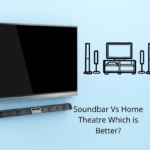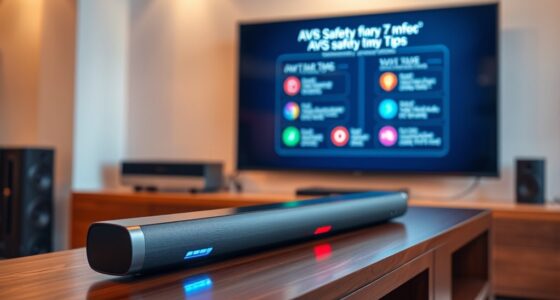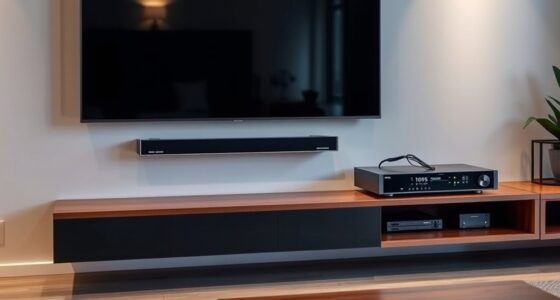If you’re choosing between a soundbar and an AV receiver, consider your needs, space, and budget. Soundbars are simple, affordable, and easy to set up, perfect for quick upgrades and space-saving setups. AV receivers offer richer sound, more customization, and expandability but require more effort to install and cost more upfront. Want to understand how each option fits your home theater? Keep exploring to find the best solution for you.
Key Takeaways
- Soundbars are compact, easy to install, and ideal for quick upgrades, while AVRs offer extensive customization and multi-channel surround sound.
- AVRs provide superior audio quality, deeper sound, and precise control over bass and treble compared to most soundbars.
- Soundbars support wireless streaming and virtual surround, but AVRs support multi-speaker setups for an immersive experience.
- Setup for soundbars is simple with minimal cables; AVRs involve complex wiring and calibration for optimal performance.
- Price-wise, soundbars are budget-friendly, whereas AVRs are a larger investment but offer greater flexibility and long-term value.
What Are Soundbars and How Do They Work?
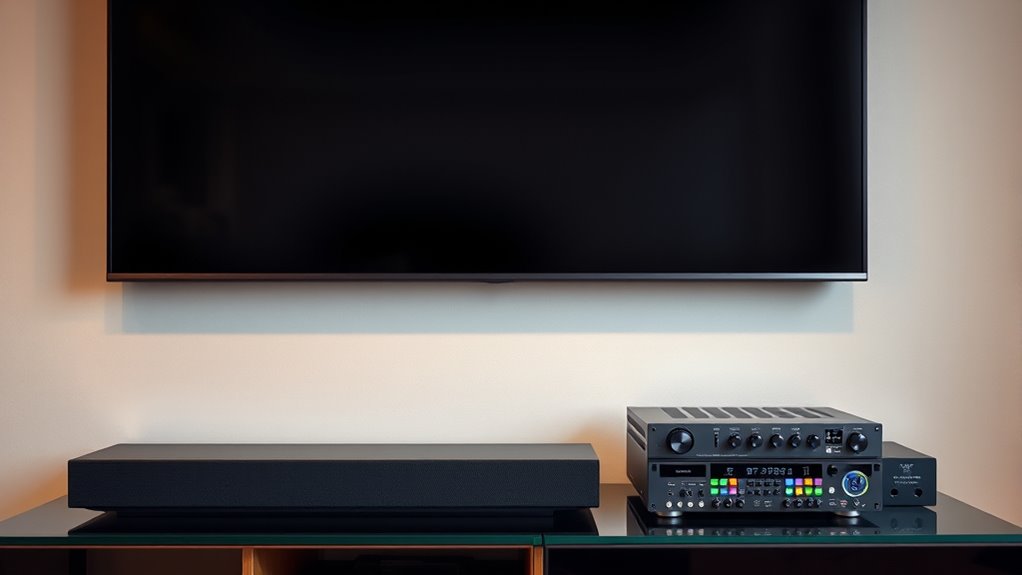
Soundbars are compact speaker systems designed to enhance your TV’s audio without the clutter of traditional home theater setups. They connect easily via wireless connectivity options like Bluetooth or Wi-Fi, making setup simple and cable-free. Soundbar placement is flexible—you can position it directly beneath your TV, mount it on the wall, or place it on a shelf. This versatility helps optimize sound quality and aesthetic appeal. Most soundbars contain multiple speakers inside a single enclosure, delivering clearer dialogue and richer sound. They often include features like built-in virtual surround sound and bass enhancement. By focusing sound in your viewing area, soundbars improve your overall TV experience without requiring complex wiring or large speaker systems. Additionally, understanding the design principles behind soundbars can help you choose the right model for your space. Knowing how they are engineered can also contribute to better sound quality and user satisfaction. A well-designed soundbar leverages acoustic engineering to maximize audio performance and ensure an immersive listening experience, which is essential for achieving the best audio performance possible. Exploring AI-driven innovations in sound technology may also lead to even more advanced audio experiences in the future.
Understanding AV Receivers and Their Functions

Understanding AV receivers starts with recognizing their role in amplification and processing audio signals, which power your speakers and enhance sound quality. They also offer a variety of connectivity options, allowing you to connect multiple devices seamlessly. By mastering these functions, you can optimize your home theater experience and get the most out of your equipment. Additionally, understanding the concept of running dry, or fatigue, can help in selecting the appropriate settings and features to prevent sound system overload and maintain optimal performance. Recognizing the importance of authenticity in sound, or delivering true-to-source audio, can further enhance your listening experience. As the automation in business landscape evolves, integrating advanced AV technology can further improve your entertainment setup and overall system reliability. Being aware of the security measures involved in payment processing can also inform how you protect your personal information when purchasing audio equipment online. Furthermore, understanding cybersecurity vulnerabilities is crucial, especially as many devices become interconnected within modern home theater systems.
Amplification and Processing
AV receivers serve as the heart of a home theater system by providing both amplification and processing for your audio and video components. They guarantee your speakers receive enough power while optimizing sound quality through advanced processing. Proper speaker placement and room acoustics are vital for achieving the best sound. The receiver’s processing capabilities help tailor audio to your space, adjusting for speaker distances and room size. This adaptive processing ensures you get balanced sound, clear dialogue, and immersive effects without needing complex setups. Additionally, sound quality enhancements like digital signal processing help improve overall audio clarity and richness. Amplification boosts the audio signals to drive your speakers effectively, while processing fine-tunes the sound for your environment. For optimal performance, understanding the importance of room acoustics can significantly enhance your listening experience. As a result, your home theater becomes more dynamic and engaging, making every movie or music session a richer experience.
Connectivity Options
Connectivity options are a key aspect of AV receivers, as they determine how easily you can connect all your audio and video devices. You’ll find wired options like HDMI, optical, and coaxial inputs, offering reliable, high-quality signals. Wireless connectivity, such as Wi-Fi and Bluetooth, provides convenience and flexibility, letting you stream music or connect devices without cables. Some AVRs support both wired and wireless setups, giving you maximum versatility. When choosing, consider the types of devices you plan to connect:
| Connection Type | Pros | Use Case |
|---|---|---|
| HDMI | High-quality video/audio | Home theater systems |
| Bluetooth | Wireless, easy pairing | Portable speakers, smartphones |
| Wi-Fi | Streaming, multi-room | Whole-home audio setup |
Additionally, many modern AV receivers are compatible with smart home integration, allowing seamless control and automation within your connected entertainment environment. Recognizing connectivity options can help optimize your setup for both performance and convenience. Being aware of input compatibility ensures your devices work harmoniously with your AV receiver and can prevent connectivity issues.
Comparing Setup and Installation Processes
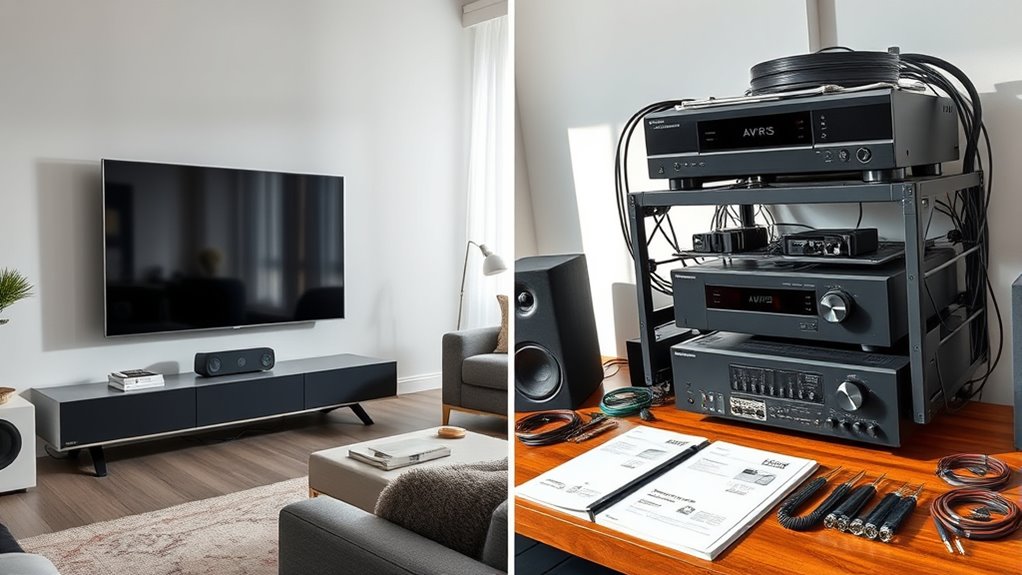
Setting up a soundbar is generally simpler and quicker than installing an AVRS system, especially if you’re looking for a hassle-free experience. Soundbars typically require minimal effort, often involving just plugging in one or two cables and placing the unit near your TV. The setup complexity is low, making it accessible for most users. In contrast, AVRS systems involve multiple components such as receivers, speakers, and subwoofers, which can take time to connect properly. You may need to configure various settings, run cables through walls, and position speakers for ideal sound. Overall, soundbars excel in installation ease, offering a straightforward process. AVRS, while more involved, provides greater flexibility at the cost of added setup complexity. For those interested in optimizing your home audio, understanding the setup and installation processes can help you make an informed choice. Additionally, understanding the component connections involved can further streamline your setup and ensure optimal sound quality. Familiarity with sound calibration techniques can also improve your listening experience and maximize system performance. Moreover, exploring audio configuration options can help tailor the system to your specific space and preferences. Learning about system compatibility can also prevent potential issues during installation and ensure seamless operation.
Audio Quality: Which Delivers Better Sound?
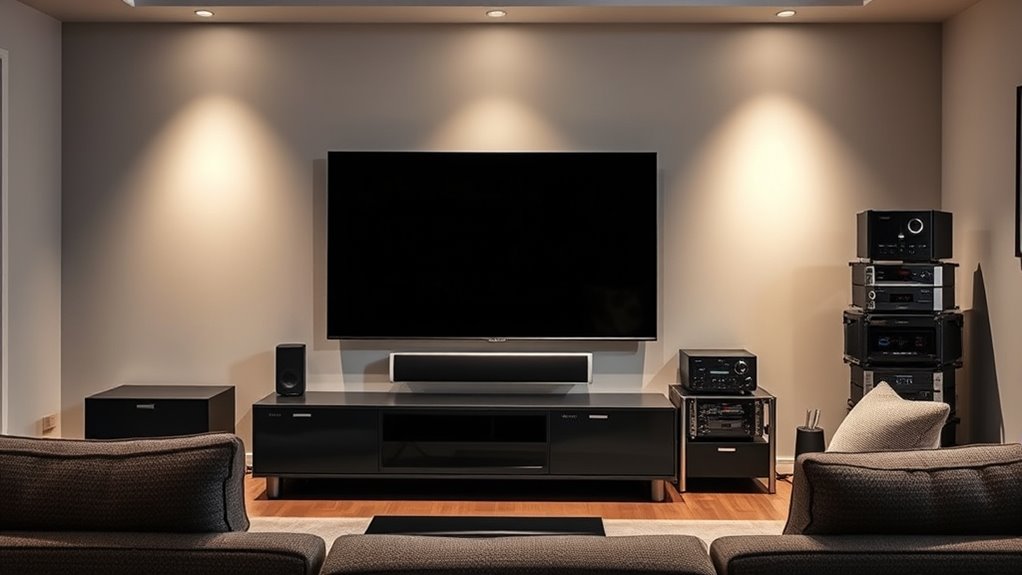
When comparing soundbars and AVRS, you’ll notice differences in clarity, depth, and overall richness of sound. Bass and treble balance play a big role in how immersive your listening experience feels, whether you’re watching movies or listening to music. Plus, surround sound capabilities influence how realistic and enveloping the audio experience becomes. Understanding the key components of sound design can help you better evaluate how each system creates a more authentic audio environment.
Sound Clarity and Depth
Soundbars often deliver clearer dialogue and fuller sound than AVRs, but the overall depth and richness of audio can vary. Your speaker placement and room acoustics play vital roles in achieving ideal sound clarity and depth. With a well-placed soundbar, direct sound projection minimizes interference from furniture and walls, enhancing dialogue clarity. Conversely, AVRs rely on multiple speakers, whose placement affects sound dispersion and depth. Room acoustics can either amplify or dampen certain frequencies, impacting how immersive your audio feels. Properly treating your space, or positioning speakers carefully, can greatly improve sound clarity and create a more balanced, three-dimensional experience. Ultimately, the combination of speaker placement and room acoustics determines how well your setup delivers sound clarity and depth.
Bass and Treble Balance
While sound clarity and depth depend largely on speaker placement and room acoustics, the balance of bass and treble plays a significant role in overall audio quality. A good bass response adds richness and depth to music and movies, making sounds feel full and immersive. On the other hand, treble emphasis highlights high-frequency details like dialogue, cymbals, and background effects, ensuring clarity and sharpness. AVRS typically offer more precise control over this balance, allowing you to fine-tune the sound to your preference. Soundbars, while often simpler, can still deliver a satisfying bass response and treble clarity, but may lack the customization found in AVRS. Ultimately, choosing between the two depends on your desire for tailored sound versus convenience.
Surround Sound Experience
Have you ever wondered which setup provides a more immersive surround sound experience? With an AVRS, you get multi-channel audio that envelops you from all directions, creating a theater-like feeling. Soundbars, on the other hand, rely on virtual surround technology, which can be impressive but often falls short of true multi-speaker setups. Consider these points:
- AVRS offers genuine surround sound with multiple speakers positioned around you.
- Soundbars use digital processing to simulate surround, which may not be as precise.
- Wireless connectivity in AVRS simplifies setup and reduces cable clutter.
- A remote control makes adjusting sound modes seamless, whether in a soundbar or AVRS.
Ultimately, AVRS tend to deliver a richer, more authentic surround experience, but soundbars are perfect for quick, space-saving upgrades.
Customization and Expandability Options
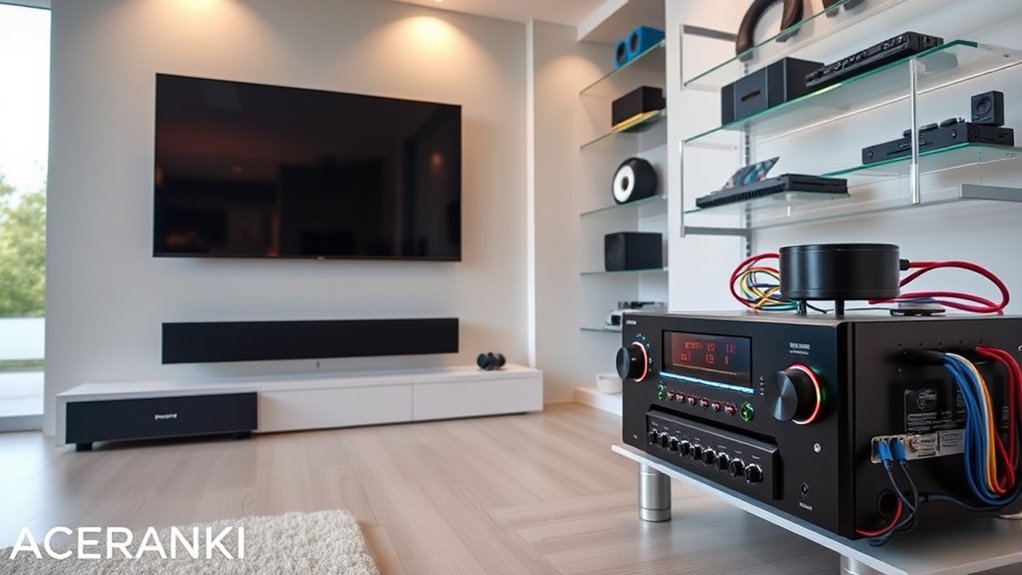
When it comes to customization and expandability, AVRs generally offer more flexibility than soundbars. With AVRs, you can add modular components like additional amplifiers, zone controls, or specialized hardware to tailor your setup. This means you can upgrade parts over time, keeping your system current without replacing the entire unit. Soundbars, on the other hand, are typically all-in-one solutions with limited options for future upgrades. While some models allow for simple connections or minor adjustments, they lack the modular design that lets you expand or customize extensively. If you value building a system that can grow with your needs and preferences, an AVR provides the necessary flexibility to modify and enhance your audio experience over time.
Price Differences and Budget Considerations
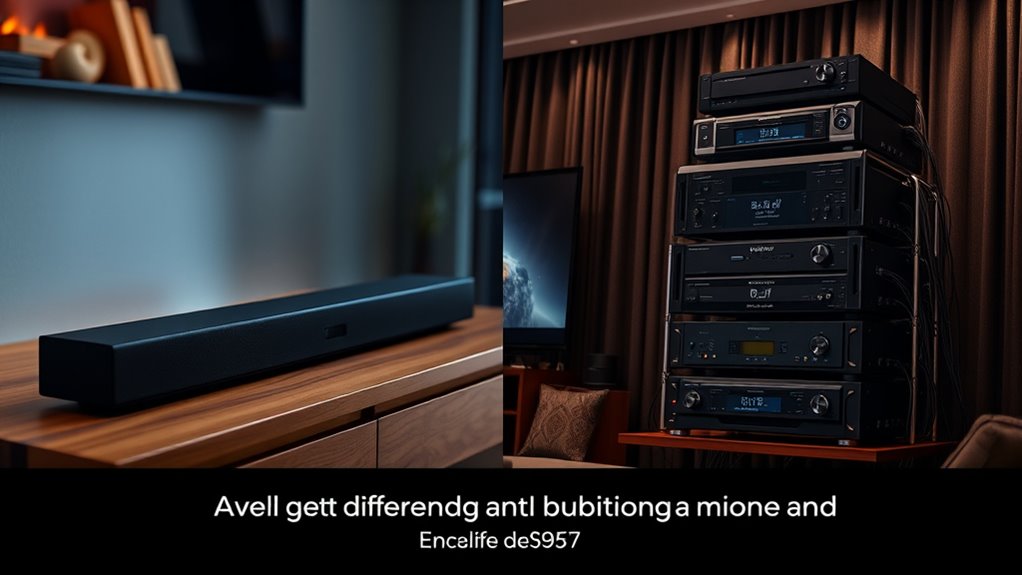
Price differences between soundbars and AVRs can considerably impact your purchasing decision, as AVRs tend to be more expensive upfront. When doing a price comparison, consider how your budget planning aligns with your audio needs.
- Soundbars generally cost less and are ideal if you’re on a tight budget.
- AVRs often involve higher initial costs but offer more customization.
- Budget planning should include additional expenses like speakers and accessories for AVRs.
- Think about long-term value—sometimes spending more upfront on an AVR pays off with better sound and expandability.
Understanding these factors helps you choose based on your financial situation and audio goals, ensuring you make a smart, budget-conscious decision.
Space and Aesthetic Factors
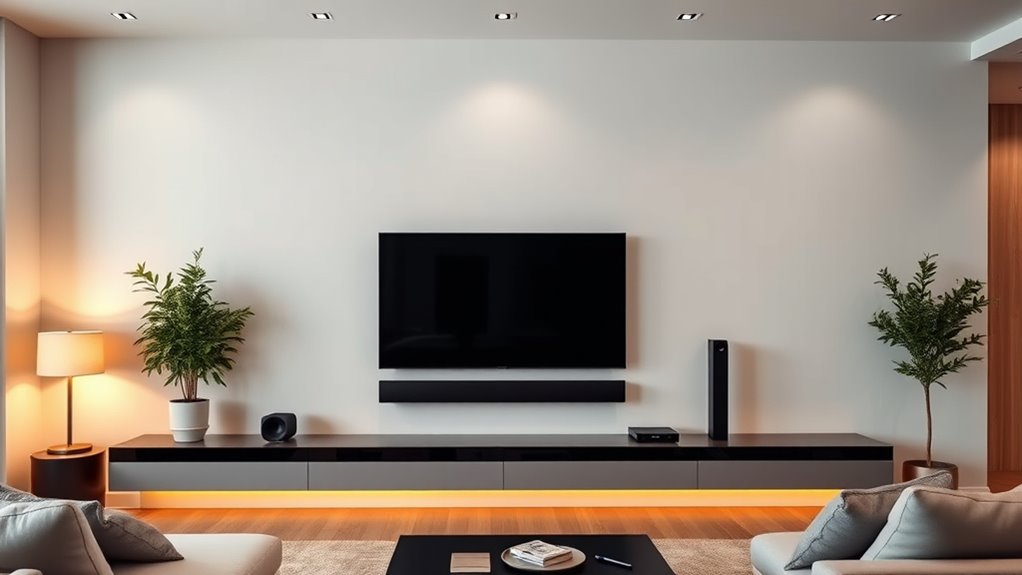
Space and aesthetic considerations play a essential role in choosing between a soundbar and an AVR setup. If you prioritize aesthetic integration, a sleek soundbar offers a low-profile design that easily blends with your TV and decor. It’s ideal for maintaining a clean, uncluttered look and fits well in smaller spaces. On the other hand, an AVR setup, with multiple components and speakers, demands more space and can disrupt the room’s aesthetics if not organized carefully. Space efficiency is paramount if you have limited room; a soundbar’s compact form minimizes clutter and simplifies placement. Conversely, an AVR provides flexibility for custom speaker arrangements, but it requires more room and may impact the visual harmony of your entertainment area. Your choice depends on balancing aesthetic appeal with available space.
Ease of Use and Control Features

Ease of use and control features are key considerations when choosing between a soundbar and an AVR setup. Your decision often hinges on how easily you can control your system. Here’s what to contemplate:
- Remote controls: Soundbars usually come with simple remotes, while AVRs often have more complex remotes with numerous buttons.
- App integration: Many soundbars support smartphone apps for quick setup and control, whereas AVRs may require more advanced apps with extensive options.
- Setup simplicity: Soundbars are typically plug-and-play, while AVRs demand more configuration.
- Customization options: AVRs offer detailed control over sound and source management, but can be overwhelming for casual users.
Choosing based on your comfort with remotes and app control will make your home theater experience smoother.
Which Solution Is Right for Your Home Theater?
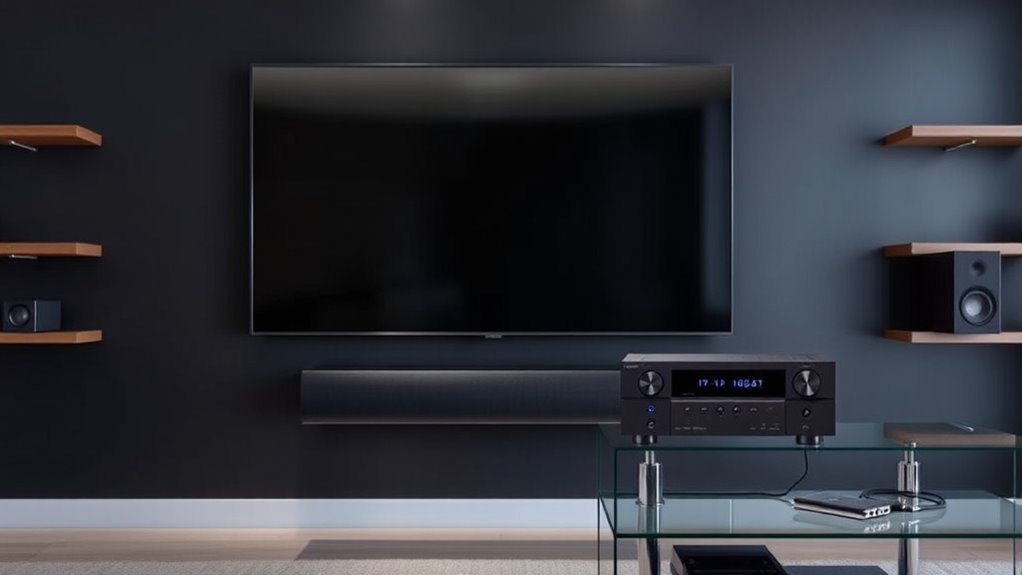
Choosing the right home theater solution depends on your viewing habits, technical comfort level, and overall preferences. If you want a simple setup with minimal fuss, a soundbar offers wireless compatibility and is easy to operate. However, if you prefer a fully customizable experience with multiple speakers, an AVRS might suit you better. Consider brand comparisons to evaluate quality, features, and compatibility with your existing devices. For example, some brands excel in wireless connectivity, making integration with smart home systems easier. Think about whether you prioritize convenience or audio precision. Your choice hinges on balancing ease of use with technical capabilities. Ultimately, assess your space, budget, and how much control you want over sound customization to determine which solution aligns best with your home theater goals.
Frequently Asked Questions
Can Soundbars and AV Receivers Support Multi-Room Audio Setups?
Yes, both soundbars and AV receivers can support multi-room expansion. Many AVRs offer dedicated multi-room audio features and wired or wireless connectivity options, making it easy to sync audio across different spaces. Soundbars, especially those with wireless connectivity options like Wi-Fi or Bluetooth, can also be integrated into multi-room setups using compatible apps or wireless speakers. This way, you can enjoy synchronized sound throughout your home effortlessly.
What Are the Compatibility Requirements for Connecting Soundbars to TVS?
To connect your soundbar to your TV, make certain it has compatible wireless connectivity options like Bluetooth or Wi-Fi if you prefer a wireless setup. Additionally, check that your TV supports HDMI compatibility, specifically HDMI ARC or eARC, for seamless audio transfer. This allows you to control volume and power with your TV remote easily. Confirming these compatibility requirements ensures a straightforward and high-quality connection between your soundbar and TV.
How Do Audio Formats Like Dolby Atmos Impact Sound Quality?
Audio formats like Dolby Atmos markedly enhance your sound experience by providing surround sound and immersive audio. Atmos adds height channels, making you feel like you’re in the middle of the action with three-dimensional sound. This creates a more realistic and engaging experience, especially with compatible speakers or sound systems. Upgrading to Atmos ensures your movies and music deliver richer, more dynamic audio that truly surrounds you.
Are Wireless Options AVailable for Both Soundbars and AV Receivers?
Yes, wireless options are available for both soundbars and AV receivers. You can find soundbars with wireless connectivity features like Bluetooth and Wi-Fi, making it easy to stream music without cables. Many AV receivers also support compatibility standards such as Wi-Fi, Bluetooth, and proprietary wireless protocols. This allows you to connect your devices seamlessly, providing a clutter-free setup while enjoying high-quality audio from your preferred sources.
What Maintenance or Troubleshooting Is Common for Each System?
You should regularly check for firmware updates to keep your system running smoothly. For both soundbars and AV receivers, speaker calibration is key—use automatic calibration tools or manually adjust settings to optimize sound. If you encounter issues like audio dropouts or connectivity problems, resetting your device or updating firmware often resolves them. Maintaining clean connections and ensuring your software is current helps prevent common troubleshooting headaches and keeps your system performing at its best.
Conclusion
Choosing between a soundbar and an AV receiver is like picking the perfect brush for your masterpiece; each brings its own flavor to your home theater. If simplicity and sleekness are your guides, a soundbar is your trusted companion. For a richer, more customizable experience, an AV receiver offers a symphony waiting to be unraveled. Whichever path you take, make sure it resonates with your space and your sound dreams, turning your room into a true audio sanctuary.
Tom is the Editor-in-Chief of 1home Theatre Projector, a website that provides news and reviews on the best home cinema experiences. With over 10 years of experience in the industry, Tom knows what makes a great home theatre projector and wants to make it easy for everyone to build the perfect setup for their needs. When he’s not busy writing or testing projectors, Tom enjoys watching classic films and spending time with his family.




